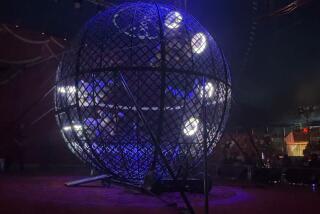Performers Get Workout in Heim’s ‘Tete au Carre’
- Share via
With enormous theatrical savvy and professional production values, Jacques Heim’s full-evening performance spectacle “Tete au Carre” polishes and popularizes the hyper-athletic, bop-’till-you-drop style of movement theater that has become so prevalent locally.
Presented over the weekend at Highways Performance Space in Santa Monica, the eight-part piece took place inside, atop and around a metal jungle-gym (designed by Greg Smith) that constantly changed with the addition of curtains, ramps, platforms and projection screens.
Designers Jennifer Azzarone, Joel Fitzpatrick and Roger Webb also contributed to the project, along with eight performers from Heim’s locally based Diavolo Dance Theatre.
Program data translated the title as “physically and mentally beating to a point of change.” It might be more appropriate, however, to call the piece “Circus of the Scars,” since it began with surreal sideshow vignettes a la the late Alwin Nikolais and then incorporated juggling, feats of balance and, especially, group gymnastics in sequences dramatizing societal aggression and requiring a high degree of physical risk.
In one full-company showpiece, everyone raced up a slant-board to the top of the set and then dropped--sometimes face down--to either a narrow wooden beam midway or to the floor below. Exciting? Of course, but when it went wrong, as it reportedly did on Thursday, performers have needed stitches.
*
No injuries seemed evident on Friday, but company members frequently looked underrehearsed--and worried. Apart from his clever, gestural modern dance commentaries on sexual politics, Heim’s choreography depended on the most familiar contact-improvisation formulas, and even at its most difficult and dangerous, the result often failed to take off either physically or conceptually.
The most successful segments included the inventive mime “snapshots” of the prologue, Heim’s volleyball game opposite Curtis Hurt (with the fearless David Salper cast as the ball), parts of the quartet about male hostility and the virtuosic interlude in which composers Juliet Prater and Jean-Pierre Bedoyan used the jungle gym as a giant percussion instrument.
More to Read
The biggest entertainment stories
Get our big stories about Hollywood, film, television, music, arts, culture and more right in your inbox as soon as they publish.
You may occasionally receive promotional content from the Los Angeles Times.










